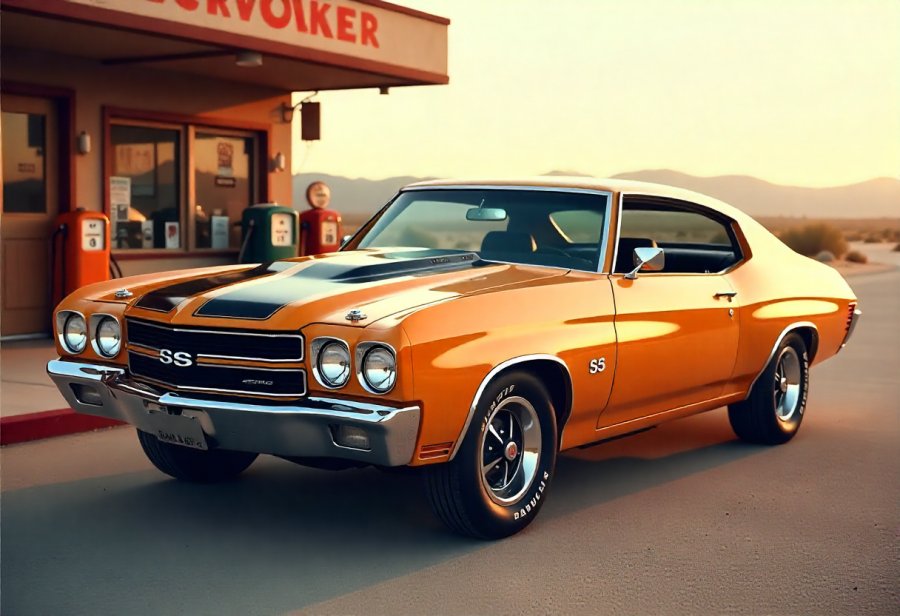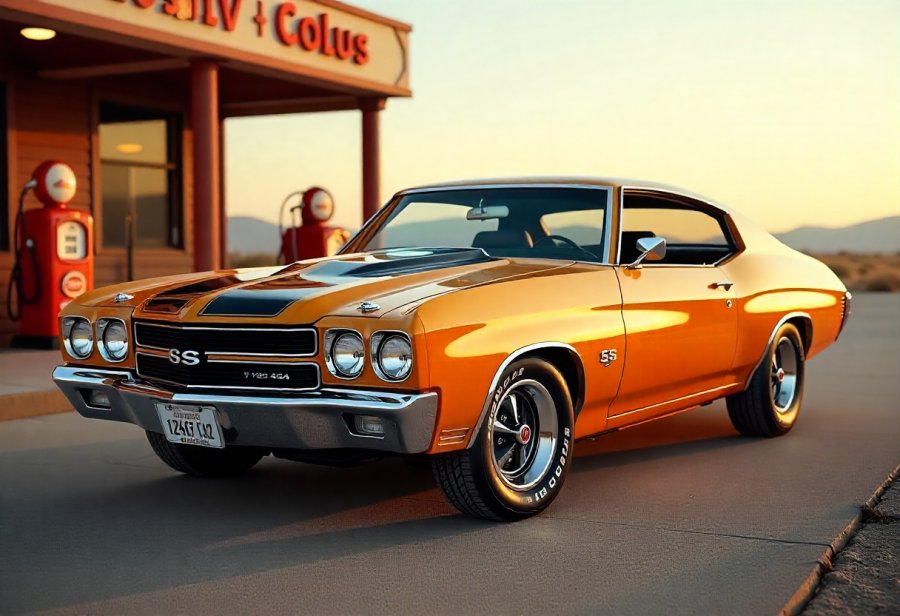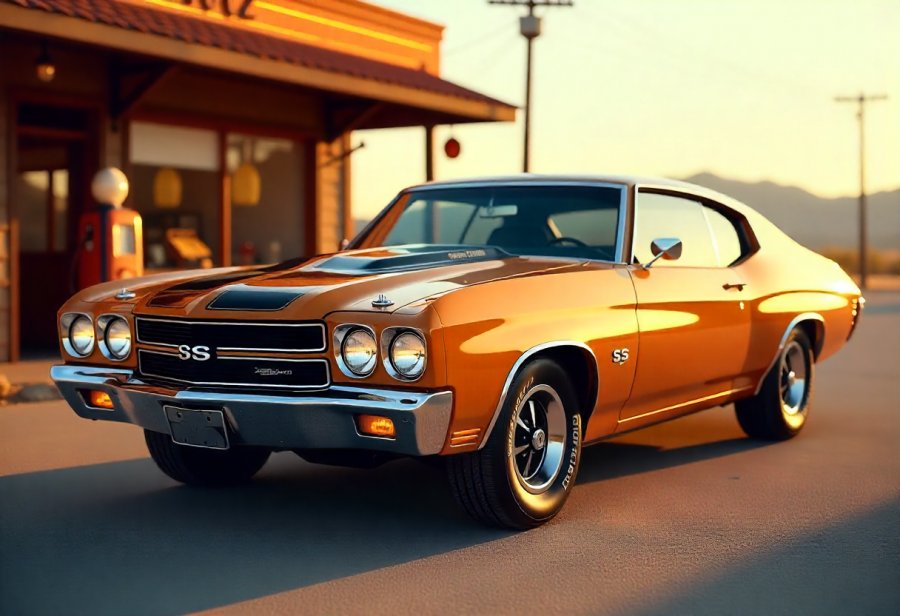
Step into the roaring heart of the 1970s muscle car era with the Chevrolet SS—an enduring symbol of American power, style, and rebellion. From its aggressive stance and iconic racing stripes to its thunderous 454 V8 engine, this car encapsulates a bygone age where horsepower reigned supreme and roads were arenas of freedom. But what truly makes the Chevrolet SS legendary isn’t just its raw performance; it’s the cultural legacy that continues to inspire enthusiasts and collectors today. As restoration techniques evolve and modern technology blends with vintage design, the question arises: how will the spirit of these iconic machines adapt to future automotive innovations? This glimpse into the muscle car’s past and future invites readers to experience the adrenaline, style, and rebellious attitude that made the Chevrolet SS an American icon—an everlasting testament to daring engineering and bold design. Are you ready to embrace its legendary roar?

The 1970s Chevrolet SS: A Symbol of Muscle Car Power and Iconic Rebellion
The 1970s Chevrolet SS stands as a defining symbol of the muscle car era, capturing the essence of American automotive innovation at its peak. During this decade, muscle cars transcended their role as mere transportation, becoming cultural icons that embodied rebellion, freedom, and individualism. Chevrolet’s SS models—whether in the form of the Chevelle, Camaro, or other variants—led this movement with their bold styling and serious performance.
This period marked a turning point where design and engineering fused to create vehicles that were as visually commanding as they were powerful. The muscular stance, characterized by wide wheel arches and a low, aggressive profile, made these cars impossible to ignore on the road. Details like cowl-induction hoods and vibrant paint options, such as Hugger Orange, signaled strength and personality, while racing stripes and chrome accents added a touch of flair.
Beneath the striking exteriors, these cars packed serious firepower. The iconic 454 cubic inch (7.4L) big-block V8 engine produced up to 450 horsepower, making it one of the most formidable engines of its time. Paired with performance-tuned suspensions and wide tires, these vehicles handled high speeds with confidence, earning their reputation on both street and strip. Inside, simplicity and control took precedence over luxury, emphasizing driver engagement and raw power.
The significance of the Chevrolet SS extends beyond its technical specs. It became a cultural icon, symbolizing American ingenuity and daring. Despite rising fuel prices and stricter regulations, models like the Chevelle SS 454 and Camaro SS continued to inspire enthusiasts and collectors alike. Their thunderous exhaust notes and striking visuals left a lasting mark on automotive history, embodying the rebellious spirit of an entire era.
In essence, the 1970s Chevrolet SS isn’t just about performance; it’s about capturing a moment in time when horsepower and style reigned supreme. Its legacy endures through bold design, powerful engines, and the rebellious attitude it embodies. As a cornerstone of American muscle car history, the Chevrolet SS continues to inspire new generations to appreciate the raw power and daring aesthetics that made these cars legendary.
Design and Style: The Bold Aesthetics That Define a Muscle Car Legend
The Chevrolet SS of the 1970s is instantly recognizable for its bold, muscular aesthetic that defined the muscle car era. Its design is all about making a statement—aggressive lines and a wide stance that exude power and speed. Wide wheel arches and a low, aggressive profile give it an imposing presence on the road, while details like racing stripes and chrome accents amplify its commanding look. These elements weren’t just for visual appeal; they emphasized the car’s performance capabilities and rebellious attitude, creating a vehicle that demanded attention wherever it appeared.
The aesthetic features of the Chevrolet SS are crafted to turn heads and evoke nostalgia. Sharp, aerodynamic lines mirror an era when cars were designed to look fast even when standing still. Contrasting racing stripes running along the hood and sides create a visual sense of movement, hinting at the speed just beneath the surface. Chrome bumpers and trim highlight the craftsmanship of the period, adding a touch of shine that contrasts beautifully with vibrant paint options like Hugger Orange and fiery reds. The cowl-induction hood, with its raised and purposeful look, signals the high-performance engine tucked underneath, seamlessly blending form and function.
Listening to the car’s deep, throaty growl transports enthusiasts back to the golden age of muscle cars. The roar isn’t just noise—it’s a visceral reminder of raw power and rebellion. The bold lines, aggressive stance, and thunderous sound work together to forge an emotional connection that’s hard to match. These cars were built to stand out, to be seen and heard, embodying a spirit of freedom and individuality that defined the era. Every detail, from racing stripes to badging, reinforces their identity as icons of American horsepower and style.
Every element of the 1970s Chevrolet SS reinforces its status as a muscle car legend. Rally wheels, period-correct badging, and bold color choices contribute to its vintage charm. The vibrant hues, like Hugger Orange and fiery reds, reflect the energetic, rebellious nature of these vehicles. These visual cues weren’t mere aesthetics—they signified a vehicle built for performance and personality. The muscular silhouette, combined with racing stripes and aggressive styling, makes these cars stand out on the road and continue to inspire admiration among enthusiasts and collectors alike.
The design of the Chevrolet SS isn’t just about aesthetics; it captures the bold, rebellious spirit of the muscle car era. Every curve, stripe, and chrome detail was deliberately crafted to evoke power and excitement. From the sleek front end to the broad rear, the design suggests speed even when parked. These cars weren’t just built to go fast—they were built to make a statement. As a piece of rolling art, the Chevrolet SS’s aesthetic continues to inspire new generations, cementing its place as a symbol of American style and performance.

In-Depth Analysis of the Chevrolet SS: Engineering, Performance, and Cultural Impact
The Chevrolet SS of the 1970s exemplifies a masterful blend of bold design and engineering innovation that left a lasting mark on muscle car history. Its muscular silhouette, characterized by a wide stance and aggressive lines, was carefully crafted to emphasize raw power and speed. Key styling features like the racing stripes and chrome accents weren’t merely decorative—they reinforced the car’s high-performance identity and rebellious spirit. The cowl-induction hood, with its prominent rise, served both aesthetic and functional purposes, improving airflow to maximize horsepower while giving the car an unmistakable, purposeful look.
Beneath its striking exterior, the heart of the Chevrolet SS was a massive 454 cubic inch (7.4L) V8 engine capable of producing up to 450 horsepower. This engine became a symbol of American muscle’s brute strength, delivering explosive acceleration and impressive straight-line speed. Paired with a performance-tuned suspension, wider tires, and a sturdy chassis, the car handled high speeds with confidence, making it a favorite among street racers and enthusiasts alike. Every component was engineered with durability and stability in mind, ensuring the vehicle could withstand aggressive driving without sacrificing reliability.
The design also incorporated aerodynamic elements, such as a sloped front end and smooth contours, which reduced drag and enhanced top speeds. Heavy-duty parts, reinforced frames, and advanced cooling systems worked together to support the demanding performance needs of these powerful machines. Whether on the street or at the strip, each detail was optimized to unleash the full potential of the car’s aggressive aesthetics. This combination of form and function created a vehicle that was as visually commanding as it was mechanically formidable.
Within the lineup, different models showcased a variety of engineering and styling nuances. The Chevelle SS 454, for instance, featured a robust body structure with wider wheel arches to accommodate larger tires and a more aggressive stance. The Camaro SS variants emphasized agility and quick handling, with sleek lines that hinted at their sporty nature. Despite these differences, each shared a core philosophy: merging muscle car aesthetics with engineering that prioritized power, speed, and driver engagement. This consistency helped cement the Chevrolet SS’s reputation as an all-American icon of performance.
Beyond raw specs and engineering prowess, the Chevrolet SS’s impact extended into cultural and enthusiast circles. Its distinctive roar, bold styling, and rebellious attitude made it a symbol of American muscle and ingenuity. Restored models command high prices at auctions, and their legacy continues through stories told at car shows and vintage racing events. The seamless integration of innovative engineering and iconic aesthetics ensures the Chevrolet SS remains a celebrated and enduring piece of muscle car history, inspiring new generations to appreciate the power and style that defined an entire era.
For enthusiasts interested in exploring more about the legacy and restoration of these classic muscle cars, there’s a wealth of information available online. Learning about the history and maintenance of models like the Chevrolet SS can deepen appreciation for their engineering and cultural significance. To discover more about the history of muscle cars and their iconic models, check out this comprehensive article on muscle car history.
Applying and Celebrating the Muscle Car Legacy: Restoring, Sharing, and Preserving American Power
Engaging with the muscle car legacy goes beyond just owning a vintage Chevrolet SS; it’s about actively immersing yourself in a community that celebrates American automotive history. Restoring a classic, whether it’s a Chevelle or Camaro, connects you directly to the rebellious spirit of the 1970s. Sourcing authentic parts, learning about the original specifications, and taking on restoration projects transform passive admiration into hands-on involvement. Every detail you restore or upgrade helps preserve a piece of muscle car culture that continues to inspire passion and pride.
Visiting car shows and muscle car meets offers a perfect chance to see these iconic vehicles up close, exchange tips with seasoned restorers, and appreciate the craftsmanship behind each restored model. These gatherings aren’t just displays—they’re lively hubs where enthusiasts share stories, showcase their projects, and keep the community vibrant. Participating in these events keeps the legacy alive and fuels your own passion for these powerful machines.
Starting a restoration can seem daunting, but breaking it into manageable steps makes the journey enjoyable. Focus on understanding your car’s original design, sourcing period-correct parts, and approaching each task with patience. Whether rebuilding the engine or refinishing the body, every small victory brings you closer to a finished masterpiece that embodies the true spirit of the muscle car era. This process not only deepens your appreciation but also creates a personal connection to the history you’re helping preserve.
Seeking advice from experienced enthusiasts can save time and avoid costly mistakes. Online forums, local clubs, and vintage car networks are filled with experts eager to share their insights. Listening to their stories and applying their tips ensures your project stays authentic and true to the muscle car’s rebellious roots. Engaging with others’ experiences turns restoration into a shared passion, making the process more rewarding and meaningful.
Maintaining a vintage muscle car involves more than occasional care; it’s about respecting its historical significance. Regular checks on fluids, brakes, and tires keep it safe and functional, while proper storage prevents deterioration. Using authentic parts and period-correct accessories helps retain its value and integrity, ensuring your car remains a genuine tribute to muscle car greatness. Each detail preserved is a step toward keeping this legacy alive for future generations.
Sharing your journey and stories with others is a vital part of celebrating the muscle car heritage. Whether through social media, local clubs, or casual conversations, telling the tales behind these cars helps pass on their rebellious spirit. Every restored detail and shared experience contributes to a living history that continues to inspire new enthusiasts. Engaging with this community keeps the power, style, and attitude of the 1970s Chevrolet SS vibrant and relevant today.

Future Perspectives and Reflection: Honoring the Legacy and Evolving the Spirit of the Chevrolet SS
The legacy of the Chevrolet SS from the 1970s remains a powerful symbol of American muscle and ingenuity. Its bold design, roaring performance, and rebellious spirit have cemented its place in automotive history. Today, enthusiasts and collectors continue to celebrate these cars, with restored models fetching high prices and commanding admiration at car shows worldwide. The enduring appeal lies not just in their raw power but in the cultural statement they made—challenging norms, embracing individuality, and fueling a sense of freedom.
Looking ahead, advancements in restoration techniques and technology promise to keep the Chevrolet SS legacy alive and vibrant. Modern tools like digital diagnostics, reproduction parts, and customized upgrades make it easier to maintain authenticity while improving performance and reliability. This blend of innovation and respect for tradition ensures that future generations can experience the thrill of these machines in their original glory or as refreshed classics that honor their roots.
Emerging trends such as electric conversions and hybrid powertrains spark debate but also highlight the adaptability of muscle car spirit. While purists may prefer untouched originals, the idea of blending vintage design with modern technology showcases how the rebellious attitude of the 1970s can evolve. These innovations demonstrate that the essence of American muscle—power, style, and attitude—can be preserved while embracing a more sustainable future. They keep the conversation alive about how classic cars can fit into a changing automotive landscape.
Culturally, the relevance of vintage muscle cars continues to grow thanks to social media, digital storytelling, and dedicated car communities. Younger enthusiasts discover these iconic vehicles through online platforms, sharing restored projects, racing stories, and nostalgic memories. This digital visibility helps pass the flame to new generations, ensuring that the rebellious, powerful spirit of the Chevrolet SS remains fresh and inspiring.
Preserving this legacy goes beyond mere nostalgia; it’s about honoring the craftsmanship, engineering excellence, and cultural impact these cars represent. They embody a time when pushing boundaries and celebrating individuality were at the heart of automotive design. Maintaining their presence in the automotive world is a tribute to that pioneering spirit, encouraging ongoing innovation rooted in the boldness of the muscle car era.
As the muscle car community continues to evolve, the story of the Chevrolet SS remains a testament to resilience and adaptability. Its iconic status, built on strength, style, and rebellious attitude, will endure as long as enthusiasts keep celebrating its history. By blending respect for tradition with new ideas, the legacy of these legendary cars will inspire future generations to appreciate the power and freedom that made the 1970s Chevrolet SS a true American icon.


